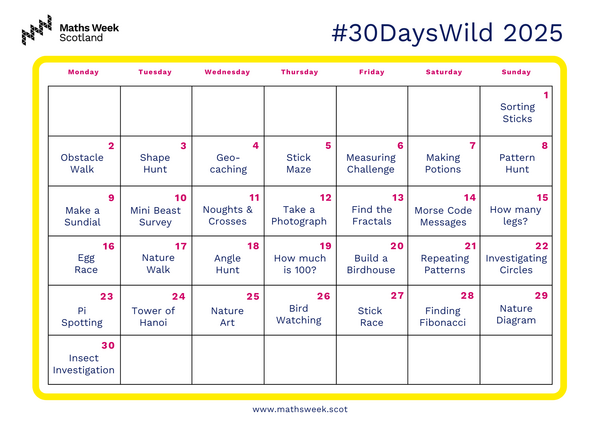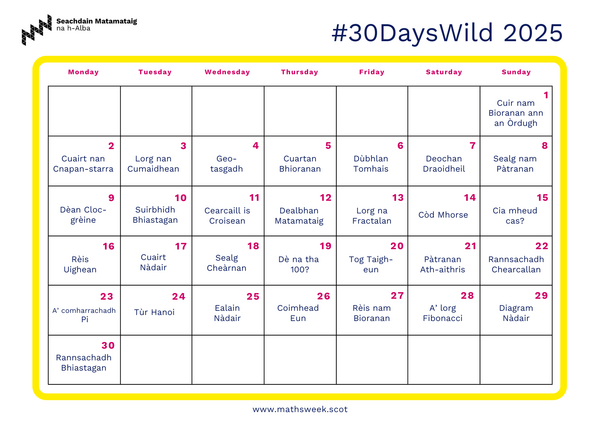30 Days Wild - 30 Latha Nàdair

It's almost time again for 30 Days Wild, the annual challenge run by the UK Wildlife Trusts during the month of June, to encourage people to spend more time outside and engage with nature. We love taking our maths outdoors, so we've come up with 30 fun ideas to get you active in nature and incorporate some maths along the way. And don't worry, there's plenty of suggestions too for those who live in very urban settings.
The resources have been updated for 2025, and are now also available in Scottish Gaelic.


Maths Outdoors: 30 Days Wild
We've created a handy calendar for you to download, with descriptions for each of the activities. Additionally, we've created a set of 30 Days Wild cards, e.g. to use in a classroom or homeschooling setting, which include a colourful image for each of the daily activities. Pick and choose the activities you like the sound of most, or try to do them all - in June, or any time!
Matamataig A-muigh: 30 Latha Nàdair
Tha sinn air mìosachan feumail a chruthachadh dhut airson a luchdachadh sìos, le tuairisgeul air gach gnìomh. A bharrachd air sin, tha sinn air seata de chairtean 30 Latha Nàdair a chruthachadh, m.e. airson an cleachdadh ann an seòmar-sgoile no suidheachadh sgoil-dhachaigh, air a bheil ìomhaigh dhathte airson gach gnìomh. Tagh na gnìomhan as toil leat, no feuch rin dèanamh uile – san Ògmhios, no aig àm sam bith a thogras tu!
We hope you have fun with our 30 Days Wild activities. We'd love to see what you get up to, so please feel free to share photos and tag us on Facebook or Bluesky. Don't forget to use the hashtags #MathsWeekScot and #30DaysWild!
Tha sinn an dòchas gum bi spòrs agaibh leis na gnìomhan 30 Latha Nàdair againn. Bu toil leinn faicinn na a bhios sibh a’ dèanamh, mar sin na bithibh leisg dealbhan a chur thugainn agus tagaichean a chur oirnn air Facebook no Bluesky. Na dìochuimhnichibh na hashtagan #MathsWeekScot agus #30DaysWild a chleachdadh!
Latest News and Events

Maths Week 2026: Maths Matters
Maths Week Scotland is back for 2026 with the theme Maths Matters. To celebrate our tenth year, we will have an extended gala week running over two weekends, from Saturday 19 to Sunday 27 September.

RSPB Big Schools' Birdwatch
It is almost time for the RSPB Big Schools’ Bird Watch – the largest citizen science project for schools across the UK. Sign up to take part, from 6th January- 13th February 2026.
